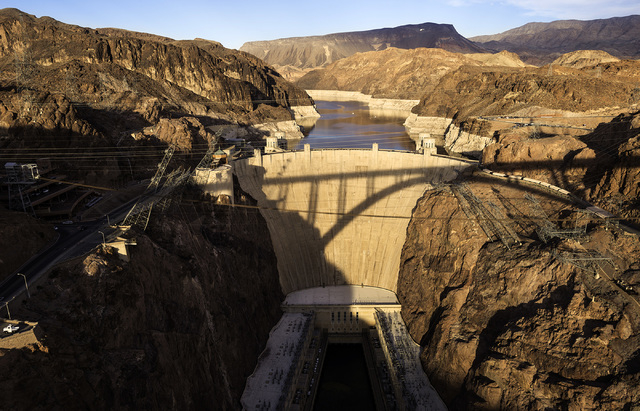Latest suicide haunts visit to O’Callaghan-Tillman Memorial Bridge

My first visit to the O’Callaghan-Tillman Memorial bridge overlooking Hoover Dam was planned weeks ago as a photographic excursion for two friends. One is an excellent photographer, while his wife has cut off my head in many travel photos.
Of course, visiting Hoover Dam is one of the top 10 free things to do in Southern Nevada. Grabbing a glimpse of engineering magnificence draws a million visitors every year to take a tour.
But last Sunday was different. As a local, I had toured the dam countless times. This trip was to walk the bridge that overlooks the dam, to see it from a unique and memorable perspective. And to take photos.
We were not the only ones walking the bridge thinking and talking about Heather Price Papayoti’s suicide on Jan. 10.
We couldn’t look down at the Colorado River 900 feet below and fail to imagine the 42-year-old woman’s last minutes, or wonder about the cause, especially since we were there near sunset, about the time she jumped to her death.
She had been so deliberate in her actions, taking a cab from Tempe, Ariz., after a behavioral counseling meeting. The drive was 280 miles long, plenty of time for her to think.
At sunset, there aren’t as many people. It’s colder. There’s a magnificent shadow of the bridge itself splayed across Hoover Dam — a photographer’s dream.
Then going down to the dam itself, we looked up and saw the new bridge and envisioned a woman falling, falling, falling.
Her family has asked for stronger safety measures to deter future suicides. But then people could simply go down to the dam itself, where the wall is shorter and easier to crawl over than the bridge.
It’s simply impossible to suicide-proof the world or every bridge.
Papayoti’s Facebook page shows a pretty blonde wearing a helmet and sun glasses. Perhaps it’s skydiving gear. She’s a fan of the Cleveland Browns. Born in 1971, she graduated from Bristol High School in 1989 in Bristol, R.I. She said her hometown was West Farmington, Ohio, and she last lived in Ahwahtukee, Ariz., an urban village annexed by Phoenix. The page said she had attended Kent State University and worked at Honeywell International.
Her family issued a statement that said: “We were blessed with her laughter and light for all the years we shared with her. Sadly the darkness of depression and anxiety consumed her in recent months and despite treatment, she was unable to conquer it.”
Since the bridge opened in October 2010, seven people have committed suicide. This one was unique because a Boulder City woman photographing the scene captured Papayoti, looking down at the dam, her shoulder reaching to the top of the bridge’s guardrail. It’s narrow enough so that people cannot stand atop it, like they do the Hoover Dam walls. But it’s not so high it can’t be climbed. A foot on the ledge below, another foot on the guardrail, and it’s over the wall. There’s no place to stand and reconsider.
San Francisco’s Golden Gate Bridge is a suicide magnet, according to an article in the Los Angeles Times in September. It’s considered the No. 1 suicide site in the United States, partly because access is easy. The railing is 4 feet high. (The O’Callaghan-Tillman bridge railing is 4 feet, 6 inches high, tall enough for a short woman to peek over.) Over the years, an estimated 2,000 people have died after jumping from the Golden Gate Bridge.
The George Washington Memorial Bridge in Seattle is the second deadliest bridge in the United States, while the San Diego-Coronado Bridge is considered the third deadliest.
John Bateson, author of “The Final Leap: Suicide on the Golden Gate Bridge,” wrote that research shows that people fixate on a particular form of death. If a bridge isn’t available, they don’t go find another way. He urged the creation of a safety net to catch jumpers. He said out of the small number of jumpers who survive “nearly all have said afterward it was the Golden Gate Bridge or nothing. They didn’t have a Plan B.”
He supported the concept of spending the money to prevent suicides from bridges.
That goes against the popular thought that people wishing to commit suicide would find another way.
I agree with the Nevada Department of Transportation official quoted in the Review-Journal who said netting would appeal to daredevils who would jump, thinking it would be fun.
The bridge didn’t kill Heather Papayoti. She killed herself.
As much as we’d like to protect everyone, our world cannot be bubble-wrapped.
Jane Ann Morrison’s column appears Monday, Thursday and Saturday. Email her at Jane@reviewjournal.com or call her at (702) 383-0275.